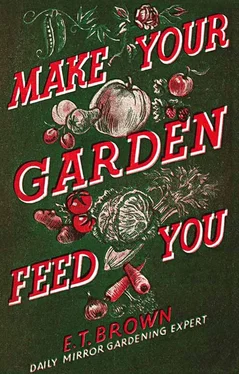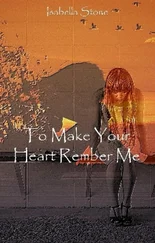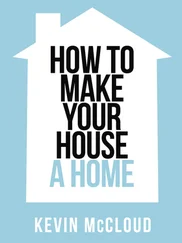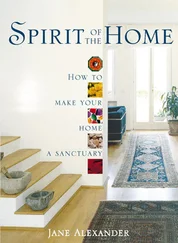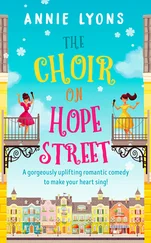The tools which are most likely to be bought at first are those used in working the soil. A good rubbing with a piece of old sacking is usually sufficient but, if the ground happens to be very wet, the tools should be scrubbed and, after drying, they should be lightly oiled. This applies to the spade, forks, rakes, hoes, trowel, and the like. Occasionally it may be necessary to file the spade a little, because, if the ground is stony, it becomes blunt in course of time.
The garden basket—this is usually oblong in shape, rounded at the bottom and fitted with a handle for convenient carrying—is apt to get wet and dirty. It should be dried carefully if only wet, but scrubbed and dried if very muddy.
If the wheelbarrow can be kept under cover all the better, but, failing this, it should be turned upside down and a sack thrown over it. The only attention it requires is for the wheel to be oiled at frequent intervals.
The edged tools are the most expensive, so after use they should be wiped dry with a clean rag and smeared with oil. They call for sharpening from time to time, a scythe stone being the most suitable agent to use.
The garden hose should never be allowed to get twisted, nor should it be allowed to lie about in hot, sunny weather, as this has a bad effect on rubber. It should be attached to a roller, and care should be taken to expel all the water as the hose is being wound up.
The syringe and sprayer should be washed out with clean water and the nozzles kept free from particles of grit. New flower-pots should be soaked in water for some hours before using, while dirty ones should be scrubbed in a mild disinfectant solution and rinsed in fresh water.
FRAMES AND THE GARDEN SHED
IN normal times most amateur gardeners endeavour to raise out-of-season crops, relying upon purchase for the ordinary vegetables when obtainable in the shops. The aim of the war-time gardener, however, is to produce as much food as possible, so extra early and late crops which occupy a considerable amount of room and involve a lot of work, together with the possession of a heated greenhouse or frames, need not be considered. At the same time, if the allotment already boasts a small greenhouse this should certainly be used. In any case one or two frames should be made or bought, since they are practically indispensable.
HOW TO CONSTRUCT A GARDEN FRAME
A frame is simply a box made rather higher at the back than at the front and fitted with a glass top. If the allotment or garden plot is of only small dimensions there is no reason why a crate should not be re-modelled and a piece of glass, say, a picture-frame, used for the top. Two or three such frames might be rigged up at little or no cost.
For the larger allotment, however, it is better to buy a three-light frame or, if the amateur gardener is handy with tools, to buy the “lights” and fashion the woodwork at home.
The usual type of frame is that known as the lean-to, as shown in Fig. 3. The ordinary light measures 6 ft. by 4 ft., so the whole structure measures 12 ft. by 6 ft. The body of the frame should be 14 in. high in front and 18 in. high at the back, and it should be made of sound boarding 1 1/ 4in. in thickness. When more than one “light” is used there must be a channelled cross-member where they come together, so that the rain which percolates between may drain away without reaching the inside of the frame, where it may do damage to young seedlings.
The series of frames should be placed directly on the ground (slightly raised, if possible, to ensure adequate drainage) and, if plants are to be grown in pots, pans, or seed-boxes, filled with a 10-in. layer of cinders or coconut fibre. If a bed is made up, in which the plants are to be placed direct, this should consist of a 10-in. layer of good garden soil.
FOR AND AGAINST A HEATED FRAME
It is questionable whether it would pay the amateur home food-producer to go in for one or more heated frames. A heated frame is mostly used for raising plants in the early part of the year before the seed can be sown outdoors so that very early crops are obtained, and this branch of gardening is not advocated at the present time. A heated frame is one raised or rested on a 4-ft. thick pile of mixed horse manure and oak and beech leaves. Stable manure is practically unprocurable nowadays, so the use of a heated frame is automatically ruled out.
There is, however, a suggestion which might commend itself to the gardener who is able to obtain a small quantity of stable manure. This is to make a sunk pit instead of a heated frame. In most cases, however, it would be better to employ the manure for digging into the soil.
To make a sunk pit, dig a hole 2 1/ 2ft. deep and 2 in. shorter and narrower than the area covered by the number of “lights” to be used. Line this with any rough, thick wood obtainable, extending the front 4 in. above ground level and the back 8 in., with the ends sloping from back to front. Prepare a mixture of stable manure and leaves, turning it over every day for a week, then put this into the pit to a depth of 18 in., compressing each layer as it is thrown in. Cover this with 3 in. of soil and then 5 in. of ashes, cinders or coconut fibre if seed-boxes are to be accommodated, or with 4 in. of soil if seeds are to be sown or seedlings planted.
Frames must be ventilated as weather conditions permit. This is done by raising the “lights” at one side—the side away from any wind that may be blowing. To do this, blocks of wood, cut in 1-in. steps, are needed. In unusually cold weather the temperature in a frame may be kept warm by putting a hot-water bottle, preferably metal, under it all night.
THREE TYPES OF FROST-PROOF GREENHOUSE
A heated greenhouse, that is, one in which a winter night temperature of round about 50 degrees F. can be maintained, is out of place on the war-time allotment, but a frost-proof one can be pressed into service and put to a good use for certain vegetable crops and for raising flowering plants for the decoration of the house.
There are three principal types of greenhouses—the span or gable, the three-quarter span, and the lean-to. The lean-to (higher at the back than at the front) is excellent when the north boundary consists of a wall, say, 8 ft. or 9 ft. high. The three-quarter span (Fig. 3) is recommended when the north wall is 6 ft. to 7 ft. high. Both of these types cost less than the span house, since one side can be dispensed with altogether, but the span greenhouse is the most practical. A useful size is 10 ft. or 12 ft. in length and 8 ft. to 10 ft. in width.
A greenhouse is allowed for in the layout (Fig. 1). If one is not erected the heap of leaf-mould with trellis-backed bed in front may be moved to the west boundary and the seed-bed and row of fruit trees or tomatoes extended to cover the extra space. In this case part of the seed-bed may be used for raising a few early vegetables or flowers for cutting.
TO BUILD AND EQUIP THE GENERAL-PURPOSE SHED
A tool-shed for storing the implements so that they are not left out in the open is a necessity on the allotment. If poultry, rabbits and bees are also kept as recommended, the tool-shed should be large enough to be used as a general-purpose shed. A convenient size is 16 ft. long by 8 ft. wide.
This shed need not be an expensive structure and, although made of surplus material, neither need it be unsightly. It should be lean-to in form, say, 6 ft. high at the back and 8 ft. high in front. There should be a door in the front—the centre is the best position—and large windows on each side.
Such a shed can be built of plywood obtained from tea-chests, timber from crates and boxes, composite board, or even a high-grade bitumen felt, on a framework of wood. Corrugated iron is a durable, not-too-expensive, roofing material. The corner uprights should be of 3 in. by 3 in. battens (natural poles of 2 1/ 2-in. or 3-in. diameter may be used if obtainable) and the intermediate uprights and the horizontals of 2 in. by 2 in. material, with 3 in. by 1 in. battens placed on edge for the rafters.
Читать дальше
